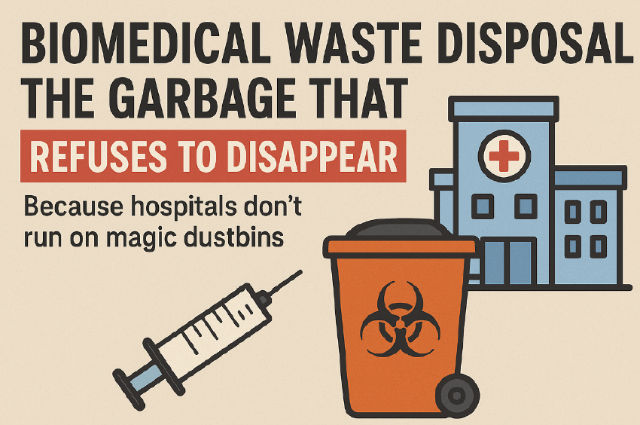
“Ever thought about this, macha — the syringe used on your mom when you were born didn’t vanish like Thanos snapped it. So, where the hell did it go?”
The Garbage We Pretend Doesn’t Exist
We humans love this “throw and forget” game. Toss a chips packet on the road? Magic — it disappears. At least that’s what our brain convinces us, because once it’s out of sight, it’s not our problem anymore.
But here’s the twist. Hospitals, labs, clinics — they play the same game. Except they’re not throwing Kurkure packets. They’re tossing syringes, blood-soaked bandages, leftover medicines, and sometimes even body parts. Yep, welcome to the horror movie no one signed up for. This is what we call biomedical waste, and unlike your Maggi wrapper, it doesn’t just vanish. It waits. And if not handled properly, it mutates into infections, pollution, and chaos — basically, nature’s revenge package.
What Even is Biomedical Waste? (Zombie Apocalypse Edition)
Let’s keep it simple. Biomedical waste is basically anything thrown away from hospitals and labs that can cause harm. Used gloves, IV tubes, blood bags, diagnostic samples, animal waste from labs, sharps like needles — the whole package.
If it looks like it belongs in a zombie apocalypse movie, it’s probably biomedical waste. The stuff isn’t just gross — it’s dangerous.
One prick from a used needle can mean a whole new disease as a bonus gift. Lovely, right?
Why Should You Care? (Hint: Because It’s Your Health)
Most of us think biomedical waste is a “doctor problem” or a “hospital problem.” Nope.
It’s a you problem, a me problem, a society problem. Here’s why:
- Health Hazards: Improperly managed biomedical waste can spread diseases like HIV, hepatitis, cholera, and dengue. So next time you walk past a pile of trash and see a random syringe poking out — maybe don’t treat it like an empty Sting bottle. That syringe has way more ‘energy’ than your energy drink, and trust me, you don’t want it.”
And if that wasn’t enough to freak you out, here’s what it does to the planet…
- Environmental Chaos: Burning plastics and medical chemicals doesn’t give you rainbow smoke. It releases toxins that hang in the air we breathe. Water bodies get contaminated, and boom — there goes your “fresh” drinking water.
- Infections Everywhere: Imagine one careless hospital staff member mixing up bins. That “one mistake” can spiral into infections spreading faster than leaked exam question papers.
Colorful Chaos – The Bin System
Now, here’s where things get interesting. Biomedical waste is supposed to be segregated into color-coded bins. Sounds simple, right?
Except in reality, it feels like India’s most ignored coloring book.
- Yellow bin: For anatomical waste (yep, body parts and tissues) and infected material. Basically, the stuff you never want to see again.
- Red bin: For contaminated plastics like IV tubes, catheters, syringes without needles. No, not your Kurkure packets — I repeat.
- Blue/White bin: For sharps like needles, scalpels, or anything that can poke and ruin your day.
- Black bin: For non-hazardous waste — think leftover food, wrappers, or regular trash.
The problem is, people either don’t know, don’t care, or think they’re playing “eeny-meeny-miny-moe” with the bins. And then they wonder why the waste management system is failing.
How Do We Dispose of It? (The Not-So-Glorious Methods)
Let’s be real — biomedical waste disposal isn’t pretty. But it’s necessary. Here are the main “techniques”:
- Incineration: Fancy word for burning. Works great, except when it chokes the air with toxins. Win some, lose some.
- Autoclaving: Basically, pressure-cooking the germs until they give up. Imagine your mom’s pressure cooker, but instead of rice, it’s killing pathogens.
- Chemical Treatment: Pour chemicals, stir well, and pray the waste stops being dangerous.
- Deep Burial: The old-school “bury it and forget it” trick. Out of sight, out of mind… until groundwater contamination comes knocking.
None of these methods is perfect, but without them, we’d basically be living in a giant biohazard dump.
India’s Situation – The Great Circus
Here’s the reality check: India generates around 500 tonnes of biomedical waste every single day. And that’s just the official number. Handling it properly is like expecting a group project to run smoothly — technically possible, practically a disaster.
- Lack of infrastructure: Not all hospitals have proper disposal facilities.
- Awareness gap: Staff don’t always follow the bin system. Some don’t even know it exists.
- Covid-19 booster shot (of waste): Remember the pandemic? Masks, gloves, PPE kits — biomedical waste skyrocketed like petrol prices. And our system could barely keep up.
Result? Mismanagement, open dumping, illegal burning — all while we’re busy scrolling reels, thinking the world is fine.
So… What Can We Do? (Yes, You Too)
- Hospitals & Clinics: Follow the damn rules. Bins aren’t decoration pieces.
- Government: Stricter monitoring, better infrastructure, and maybe some real penalties.
- You & Me: Stop tossing your COVID mask in the kitchen bin. Small actions = big difference.
It’s not rocket science. It’s just common sense.
Respect the Bin...
At the end of the day, biomedical waste disposal isn’t just some hospital’s homework. It’s literally about whether you and I breathe clean air, drink safe water, and stay disease-free.
So next time you see a color-coded bin, don’t treat it like background furniture. Respect the bin, da. Because those bins are silently fighting battles we don’t even see. And trust me, you don’t want to be on the losing side of this war.
